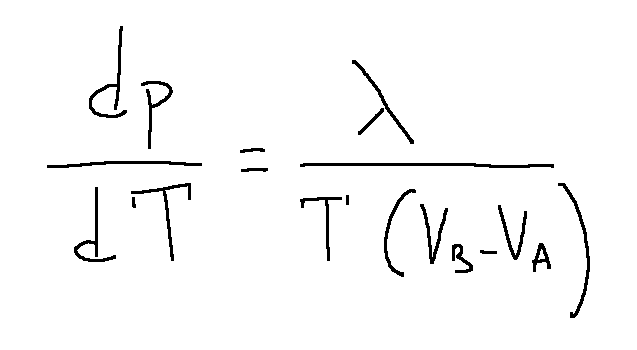05-01-2024 - Physics - Clapeyron [EN]-[IT]

~~~ La versione in italiano inizia subito dopo la versione in inglese ~~~
ENGLISH
05-01-2024 - Physics - Clapeyron [EN]-[IT]
Clapeyron
Benoît Paul Émile Clapeyron was a French physicist and railway pioneer who lived in 1800.
In the field of physics he is known for the Clapeyron equation, an equation that bears his name.
The Clapeyron equation describes the variation of pressure with temperature along the equilibrium curve of a substance.
The equation is shown below.

Where:
p = the pressure
T = the temperature
λ = the latent heat (per unit mass) of transition from phase A to phase B.
V = the specific volume of the two phases A and B.
the Clapeyron plane - adiabatic transformation
Let's take an adiabatic transformation for example. Recall that an adiabatic transformation is a thermodynamic transformation in which no heat exchanges occur between the system and the external environment.
Let's imagine we have a cylinder into which we lower the piston. The cylinder has adiabatic walls and the piston moves from top to bottom reaching the middle of the cylinder/vessel.
This transformation is also called isentropic as it is reversible and is a transformation that occurs at constant entropy, so Sf = Si (final entropy equal to initial entropy)
The graph of what is described will be more or less like the following:

An adiabatic transformation on the Clapeyron plane is represented by a fairly inclined hyperbola.
the Clapeyron plane - isothermal transformation
Let's always imagine having a container with a piston, i.e. the case studied previously, but this time let's consider that the walls are not adiabatic.
An isothermal transformation is a thermodynamic transformation at constant temperature, therefore Ti = Tf (initial temperature is equal to final temperature)
Clapeyron's plan will look like this

An isothermal transformation on the Clapeyron plane is represented by a tilted hyperbola.
Conclusions
If we consider the Claperyon plane we can notice that both in an adiabatic and isothermal transformation the graph will show us a hyperbola, but in the adiabatic transformation the hyperbola is more inclined.
Request
Have you already heard of the French physicist Clapeyron? Did you know that he was a key person in the creation of rail transport?

05-01-2024 - Fisica - Clapeyron [EN]-[IT]
Clapeyron
Benoît Paul Émile Clapeyron è stato un fisico francese, pioniere della ferrovia, vissuto nel 1800.
Nel campo della fisica è noto per l'equazione di Clapeyron, equazione che porta il suo nome.
L'equazione di Clapeyron descrive la variazione della pressione con la temperatura lungo la curva di equilibrio di una sostanza.
Qui di seguito è rappresentata l'equazione.

Dove:
p = la pressione
T = la temperatura
λ = il calore latente (per unità di massa) di transizione dalla fase A alla fase B.
V = il volume specifico delle due fasi A e B.
il piano di Clapeyron - trasformazione adiabatica
Prendiamo ad esempio una trasformazione adiabatica. Ricordiamo che una trasformazione adiabatica è una trasformazione termodinamica in cui non avvengono scambi di calore tra il sistema e l'ambiente esterno.
Immaginiamo di avere un cilindro nel quale abbassiamo il pistone. Il cilindro ha pareti adiabatiche ed il pistone si muove dall'alto verso il basso raggiungendo la metà del cilindro/recipiente.
Questa trasformazione è detta anche isoentropica in quanto reversibile ed è una trasformazione che avviene a entropia costante, per cui Sf = Si (entropia finale uguale a entropia iniziale)
Il grafico di quanto descritto sarà più o meno come il seguente:

Un trasformazione adiabatica sul piano di Clapeyron è rappresentata da un iperbole abbastanza inclinata.
il piano di Clapeyron - trasformazione isoterma
Immaginiamo sempre di avere un recipiente con un pistone, cioè il caso studiato in precedenza, ma consideriamo questa volta che le pareti non siano adiabatiche.
Un trasformazione isoterma è una trasformazione termodinamica a temperatura costante, quindi Ti = Tf (temperatura iniziale è uguale alla temperatura finale)
Il piano di Clapeyron sarà simile al seguente

Un trasformazione isoterma sul piano di Clapeyron è rappresentata da un iperbole inclinata.
Conclusioni
Se consideriamo il piano di Claperyon possiamo notare che sia in una trasformazione adiabatica che isoterma il grafico ci mostrerà un iperbole, ma nella trasformazione adiabatica l'iperbole è più inclinata.
Domanda
Avevate già sentito nominare il fisico francese Clapeyron? Sapevate che fu una persona chiave nell'ideazione del trasporto su rotaia?
THE END
Sometimes I usually wonder how scientists mix numbers and alphabets to calculate them together
That’s so brilliant
Real! However, the pressure - volume graph is also called Clapeyron graph, as it was the first to study thermodynamic transformations with p and T
Scientists are actually doing a great job making discovery of huge things
I agree! Furthermore, thermodynamic studies are becoming increasingly complex, especially in the study of heat dispersion in homes
I so much love the world of physics. So much to learn from it
Thanks for this answer, then you and I will have fun for a few months, I plan to talk about physics until March
!PIMP
!discovery 20
You must be killin' it out here!
@libertycrypto27 just slapped you with 5.000 PIMP, @stefano.massari.
You earned 5.000 PIMP for the strong hand.
They're getting a workout and slapped 2/2 possible people today.
Read about some PIMP Shit or Look for the PIMP District
Grazie per la segnalazione. La cultura su HIVE paga
This post was shared and voted inside the discord by the curators team of discovery-it
Join our Community and follow our Curation Trail
Discovery-it is also a Witness, vote for us here
Delegate to us for passive income. Check our 80% fee-back Program